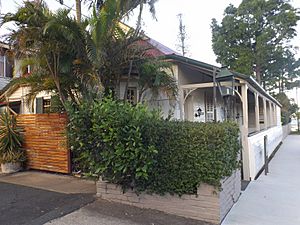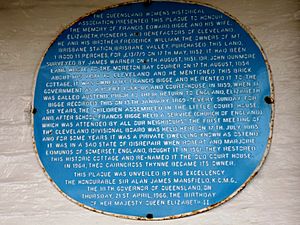Old Cleveland Court House facts for kids
Quick facts for kids Old Cleveland Court House |
|
|---|---|

Front entrance, 2015
|
|
| Location | 1 Paxton Street, Cleveland, City of Redland, Queensland, Australia |
| Design period | 1840s - 1860s (mid-19th century) |
| Built | 1853 - 1977 |
| Official name: Ye Olde Court House Restaurant, Cleveland Court House & Lockup, Ostend | |
| Type | state heritage (built) |
| Designated | 21 October 1992 |
| Reference no. | 600770 |
| Significant period | 1850s-1880s (historical) 1853-1900s (fabric) |
| Significant components | residential accommodation - workers' quarters |
| Lua error in Module:Location_map at line 420: attempt to index field 'wikibase' (a nil value). | |
The Old Cleveland Court House is a special old building in Cleveland, Australia. It was built a very long time ago, starting in 1853. Over the years, it has been used for many different things. Today, it is known as the Ye Olde Court House Restaurant. This building is so important that it is officially listed on the Queensland Heritage Register.
Contents
What is the Old Cleveland Court House?
The Old Cleveland Court House is a historic building located at 1 Paxton Street in Cleveland. It started as a simple brick building and has been changed and added to over many years. It is recognized for its long history and how it shows the changes in Cleveland.
A Look Back: The Building's History
The main part of this building, made of brick, was likely built around 1853. It was bought by two brothers, Francis Edward Bigge and Frederick William Bigge. They were important people who were developing businesses in Cleveland at the time.
Early Days: Worker Quarters
The Bigge brothers were involved in trading, timber, and shipping at Cleveland Point. This area was once a port for Dunwich, which was a place where prisoners were sent a long time ago. The Bigge brothers probably built this house as a place for their workers to live.
Serving the Law: Court House and Lockup
Later on, the building was rented out to the police chief. It became the home for the local police, a court house where legal cases were heard, and even a lockup (a small jail). It served as an important place for law and order in the area until about 1880.
New Owners and Changes
In 1882, a man named William Davidson Ross bought the property. He was a retired furniture dealer from Brisbane and later became a leader in the Cleveland community. He lived in the house himself. Over time, the building was made bigger, probably in the late 1800s or early 1900s.
From Home to Restaurant
The building stayed a private home until the early 1960s. Then, it was changed into a tearoom, a place where people could go for tea and snacks. In 1977, a large new section was added to the building. This made it much bigger and turned it into the restaurant it is today.
What Does It Look Like?
The oldest part of the building, which was the former court house, is a single-story brick building painted a light color. It sits close to the sidewalk on Paxton Street, which goes down to Moreton Bay.
The roof is made of corrugated iron and slopes downwards, covering the front and back areas. The front of the building has a porch area that is partly covered with wooden boards. This porch has simple wooden posts and supports.
The windows on the front wall have six small glass panes that open inwards. The window sills are made of stone. Inside, the walls are made of painted brick. The ceilings are made of wooden boards, and many of them have round, decorative vents in the middle. There is an old brick fireplace that is still used sometimes. Another fireplace, which came from the historic Bellevue Hotel in Brisbane, was added to the newer part of the building. The newer restaurant section also includes other old pieces from different historic buildings.
The Old Cleveland Court House still has its special old look, especially the low-set open porch at the front, which is a well-known feature on Paxton Street.
Why is it Important?
The Old Cleveland Court House was officially listed on the Queensland Heritage Register in 1992. This means it is a very important building for several reasons:
- It shows how Queensland's history has changed. The building, especially its oldest part from 1853, helps us understand the very first European settlements in Cleveland. It also shows how law and order were set up in the Redland area a long time ago.
- It is beautiful and adds to the area. The building, especially its unique bowed porch, makes Cleveland Point look special. People in the Cleveland community really value how it looks, especially as it sits low and close to the street leading to the sea.


